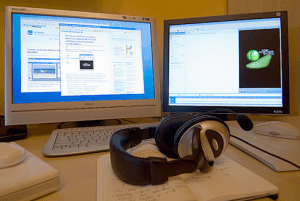The rise and rise of screencasts
By Clive Young, on 16 June 2013
 Over the last few years we have seen a remarkable growth in the use of screencasts at UCL. A ‘screencast’ is simply a dynamic video recording of live computer screen activity. Unlike a screenshot, which is basically a static image, screencasts capture video sequences of clicks and screen changes often enhanced with an audio explanation. The audio can be captured ‘live’ or added on later.
Over the last few years we have seen a remarkable growth in the use of screencasts at UCL. A ‘screencast’ is simply a dynamic video recording of live computer screen activity. Unlike a screenshot, which is basically a static image, screencasts capture video sequences of clicks and screen changes often enhanced with an audio explanation. The audio can be captured ‘live’ or added on later.
The method was first popularised in the 90s via the Windows tool ScreenCam (formerly Lotus ScreenCam) designed for software demonstrations and tutorials. Like all modern screencast tools, ScreenCam allowed various visual effects such as zooming, highlighting and labelling to be added. Its main advantage was ease-of-use, requiring no knowledge of video editing and soon became widely used by teachers as a way of converting of PowerPoint presentations to short movies in the the Adobe Flash format.
In the last decade there has been an rapid growth of screencasting tools, some downloadable like ScreenCam to a PC, Mac or mobile device but many others now recording directly to the cloud so that they can be published via social media. UCL’s institutional system Echo360 (Lecturecast) includes a screencast facility as part of its lecture capture tools, allowing academics to create short videos without needing a live lecture setup. This has provided a logical ‘next step’ for colleagues inspired to move beyond conventional lecture capture, and many use cloud-based services such as YouTube and Vimeo in addition to publishing via the lecture capture system.
Such recordings are currently being used at UCL in a number of ways, for example:
- To ‘flip‘ lectures – i.e. pre-record a lecture, publish this material along with an associated feedback channel e.g a Moodle forum or the Lecturecast systems inbuilt discussion facilities and use face-to-face time to clarify and discuss issues picked up through student feedback.
- To produce supplementary materials to live lectures.
- To record talks introducing and contextualising areas of study – e.g. talks to students that help to inform choices regarding their direction of study.
- The production of materials for distance learning.
In an earlier blog post I reviewed Davis and Hardman’s 2012 report on how short Echo 360 screencasts (up to 10 minutes) could supplement ‘conventional’ teaching such as lectures and labs. They found a number of uses, contextualisation (associated with ‘flipping’), assessment preparation and cohort-level feedback. The approach seemed to be time-saving, students were happy with the ‘rough and ready’ production values of scfreencasts and the project identified some difference in marks when students used the the contextualisation screencasts.
How can you get started? For UCL academic staff with an account on the Lecturecast service the EchoCapture Personal installer can be quickly downloaded for Mac OS X and Windows 32 systems. Recordings are easy to make and edit and can then be uploaded directly to the Echo System Server (ESS) where they can, like recordings made in LectureCast equipped theatre spaces, be made available as streamed and downloadable versions.
Other screencasting tools: For those happy to go ‘off-piste’ there are lots of screencasting tools out there, e.g. 18 Free Screencasting tools to Create Video Tutorials Some of the more common ones seem to be Camstudio, Jing, Screentoaster, Screenr and Screencast O matic. Screencasting iPads is much less easy but Screencasting Smackdown – Videos in the Classroom lists several tools. For example the Explain Everything app provides a useful recordable whiteboard used by several UCL colleages for freehand drawing of diagrams and equations.
Tips and tricks: Although technically simple, good screencasting needs just a little forethought. A sensible general introduction is is Screencasting 101 – Fundamentals of Screencastin. As a follow up I rather like an amusing 10′ video by Dan Nunez, The 10ish Commandments of Screencasting.- the first of Dan’s Commandments is Hide the Goods! For a more educational focus try Quick start guide to flipping your classroom using screencasting or lecture videos . Screencasting Variety Showcase is a highly recommended recorded JISC conference session on the possibilities of screencasting by Phil Ackroyd (City College Norwich). Finally JISClegal podcasts about Recording Lectures and Screencasts is a practical ‘how to’ also covering some of the legal, technical and accessibility issues.
For lots more information on lecture capture innovation visit my Scoop.it site REC:all (recording and augmenting lectures for learning).
Image by Manuela Hoffman http://www.flickr.com/photos/pixelgraphix/153725264
3 Responses to “The rise and rise of screencasts”
- 1
-
2
Bobby wrote on 9 September 2013:
Thanks for the blog
two of my favorite ones are :CamStudio and Camtasia Studio
-
3
Ron Starc wrote on 24 July 2014:
My Screen Recorder Pro is an excellent screencasting tool. Records your screen and audio from the speakers or your voice from the microphone – or both simultaneously. The recordings are clear and look great when played back on your PC or uploaded to YouTube. It will record directly to AVI, WMV, MP4, or FLV. Just perfect for creating tutorials, demos, and presentations.
http://www.deskshare.com/video-screen-capture.aspx
 Close
Close


Great post on screencasting options from @CliveYoung http://t.co/PFaRjZQ3Ku #flippedlecture